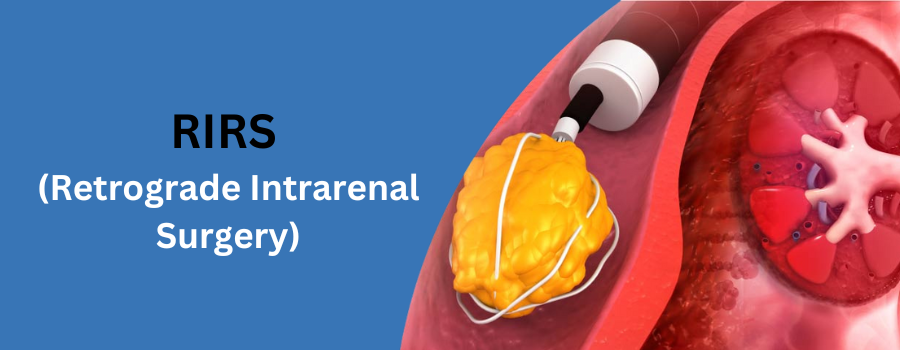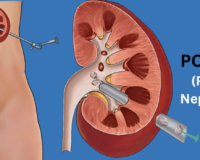RIRS-Requirement, Preparation & After Effects
Kidney stones form as a result of hard minerals and salt crystals in the kidney. Depending on the size and location of the kidney stone, the doctor may prescribe a non-surgical treatment or use of sound waves or laser therapy to remove the stones. Out of all the kidney stone treatments accessible, Retrograde Intrarenal Surgery RIRS is the most dependable and modern kidney stone laser surgery. If you have kidney stones and your doctor recommends an RIRS, you must fully understand the procedure in order to make informed decisions regarding your health.
RIRS stands for “Retrograde Intra Renal Surgery.” It is a minimally invasive surgical procedure used to treat kidney stones. The procedure is performed by entering the kidney through the ureter, the tube that carries urine from the kidney to the bladder, rather than through an incision in the abdomen. This allows the surgeon to remove the stone using small instruments while causing less damage to the surrounding tissue.
When is RIRS Surgery needed?
RIRS (Retrograde Intrarenal Surgery) is typically needed when a patient has a large kidney stone that cannot be effectively treated with other methods, such as shock wave lithotripsy or ureterorenoscopy.
Additionally, RIRS may be used in cases where a patient has a small kidney stone that is located in a difficult-to-reach area of the kidney, or in patients who are unable to undergo general anaesthesia. It may also be considered in patients who have had previously failed ureterorenoscopy.
The procedure is typically recommended after a detailed assessment of the patient’s medical history, physical examination and imaging studies. A urologist is the one who performs this surgery.
How to prepare for an RIRS surgery?
To get ready for a retrograde intrarenal surgery (RIRS), you should:
- Talk to your surgeon about the pros and cons of the surgery.
- Get any blood tests or imaging tests that need to be done done before the surgery.
- Follow your doctor’s advice about what to take, what to eat, and how much you can do.
- Tell your surgeon if you have any allergies or health problems.
- Plan for someone to drive you home and stay with you for the first 24 to 48 hours after the procedure.
- On the day of surgery, wear loose, comfortable clothes to the hospital.
- It’s also important to follow any other instructions your surgeon or health care team gives you to make sure the surgery goes as well as possible.
What happens in an RIRS surgery?
During an RIRS (Retrograde Intrarenal Surgery) procedure, a small incision is made in the patient’s back, and a thin, flexible tube called a ureterorenoscopy is inserted through the incision and guided into the patient’s kidney. The ureterorenoscopy has a small camera on the end, which allows the surgeon to visualize the inside of the kidney and locate the kidney stone.
Once the stone is located, the surgeon uses small instruments that are passed through the ureterorenoscopy to fragment the stone into smaller pieces. These pieces can then be easily removed or passed through the urinary tract.
The procedure is typically performed under general anaesthesia and takes around 60-90 minutes. The patient may experience some discomfort or pain following the procedure, which can be managed with oral pain medication.
Most patients are able to return to normal activity within a few days, although it is recommended to drink a lot of water to help the remaining fragments to pass through the urinary tract.
What happens after an RIRS surgery?
After a Retrograde IntraRenal Surgery (RIRS), the patient usually stays in the hospital for one to two days to be watched. They might feel pain or discomfort where the scope was put in, and they might be given painkillers. The patient will be told how to take care of the cut and told to drink a lot of fluids to help flush out any small pieces of stone that may be in their urinary tract.
They might also get antibiotics to help keep them from getting sick. Most people can go back to normal activities within a few days, but they shouldn’t do anything too hard for a week or two. The patient will need to check in with their urologist to see if there are any problems or if the cancer comes back.
FAQs on RIRS
How does RIRS surgery work?
Retrograde intrarenal surgery (RIRS) is a procedure that is used to treat kidney stones with the least amount of damage. It is done by putting a small tube (called a ureterorenoscope) into the urethra and bladder and moving it up to the kidney.
What benefits does RIRS surgery have?
Traditional open surgery is more invasive than RIRS surgery. This means that RIRS surgery is less painful and takes less time to heal from. It also causes less blood loss and makes complications less likely.
Who could benefit from RIRS surgery?
Most of the time, RIRS surgery is recommended for people with kidney stones in the renal pelvis or lower ureter that are between 4 and 20 millimetres in size.
How long does RIRS surgery take?
Most of the time, the procedure takes between 30 minutes and an hour.
What are some of the risks of RIRS surgery?
RIRS surgery can cause problems like bleeding, infection, or damage to the ureter or kidney.
How long will it take before I can get back to my normal life after RIRS surgery?
Recovery time varies from person to person, but most people can get back to their normal lives within a few days.
During the procedure, will the stones be taken out?
The RIRS procedure breaks the stones into small pieces and then suctions them out. If the stones are too small or too hard to remove, they may be left behind.
Will I need another procedure?
In some cases, another procedure may be needed to get rid of any small pieces of stone that are left behind or to remove new stones that form in the future.



